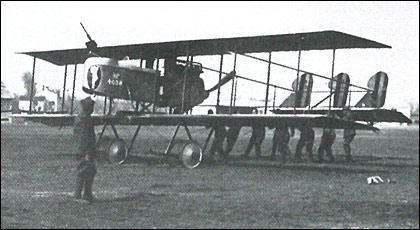| Alberto Rizzi, e-mail, 19.02.2018 22:51 Copied from the Maurice Farman MF 11, this aircraft evolved in the S.P.2 (the aircraft showed in the photograph: the S.P.1 was unarmed and with rudders of different shape), a similar reconnaissance and close support airplane, built in 402 units and that was in service from December 1916 until the end of the W.W. I, at least with 25 "Squadriglie". Experimentally one S.P.2 had the nose mounted 6,5 mm. (.26") Revelli machine gun replaced by a 25 mm. (.98") Revelli hand operated light gun for close support, becoming the S.P.2bis (= Mk II).
With a 300 CV (= 161 kW) FIAT engine and a reduced wingspan it became the S.P.3, that made its first flight in 1917 showing a speed increased to 145 Km /h (= 90 m.p.h.); despite the obsolescence of this formula, it totalized more or less 300 airplanes built.
The Savoia-Pomilio projected also a two puller engines bomber version, again with central nacelle and double booms: the "AER" factory built under license 152 "S.P.4" between 1917 and 1918, that were used instead only for reconnaissance missions. Their engines were two 150 CV (= 80 kW) Isotta-Fraschini V4B; with a crew of three they had two machine guns, one in the front and the other in the rear of the nacelle.
S.P.2 main characteristics:
1 x 250 CV (= 184 kW) FIAT A.12
Empty weight: 1.250 Kg. (= 2,753 lbs)
Take off weight: 1.700 Kg. (= 3,744 lbs)
Length: 10,77 m. (= 35' 4")
Wingspan: 16,74 m. (= 54' 11")
Height: 3,85 m. (= 12' 5")
Max speed: 120 Km /h (= 74 m.p.h.)
Max range: 450 Km (= 280 miles)
Max ceiling: 5.000 m. (= 16,400')
Armament: 1x6,5 mm. (.26") Revelli hand operated machine gun (1x25 mm. (0,98") Revelli hand operated light cannon in the nacelle nose, the S.P.2bis). reply |
| Terrence Murphy, e-mail, 04.02.2012 15:52 The Savoia-Pomilio SP.1 was a reconnaissance and bomber aircraft built in Italy during the First World War. The pilot and observer sat in tandem in an open nacelle with the engine mounted pusher-fashion at its rear. This nacelle was mounted on struts in the gap between biplane wings, and a twin-tail arrangement linked by a common horizontal stabilizer was carried on booms that extended aft from the wings SIA built the prototype at its factory in Turin, and while this was the only example constructed, it served as the basis for a number of follow-on designs.
General characteristics
• Crew: Two, pilot and observer
• Length: 10.70 m (35 ft 1 in)
• Wingspan: 16.80 m (55 ft 1 in)
• Wing area: 68 m2 (730 ft2)
• Gross weight: 1,850 kg (4,070 lb)
• Powerplant: 1 × Fiat A.12, 190 kW (250 hp)
Performance
• Maximum speed: 115 km /h (72 mph) reply |









